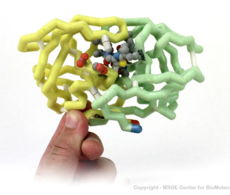Immunodeficiency virus protease
From Proteopedia
(Difference between revisions)
| Line 14: | Line 14: | ||
There currently is no cure or vaccine against HIV. Researchers, however, have discovered treatments that can halt and even reverse the progression of AIDS, due in large part to our understanding of the structure of HIV-1 protease. <scene name='User:David_Canner/Sandbox_HIV/Saquinavir/4'>Saquinavir</scene> ([[Invirase]]) was the first protease inhibitor approved by the FDA for the treatment of HIV. It inhibits HIV protease by <scene name='User:David_Canner/Sandbox_HIV/Saquinavir_tunnel/1'>binding tightly in the active site tunnel</scene>, preventing the binding of polyproteins. Its chemical structure mimics the tetrahedral intermediate of the hydrolytic reaction, thereby <scene name='User:David_Canner/Sandbox_HIV/Saquinavir_cat/3'>interacting strongly with the catalytic Asp residues</scene>.<ref>PMID:17243183</ref> Saquinavir is essentially an uncleavable ligand, as indicated by the <scene name='User:David_Canner/Sandbox_HIV/Hiv_morph2/9'> similar conformational changes in the protease flaps </scene> on binding saquinavir or a polypeptide. Resistance to saquinavir is due to alterations in the HIV protease sequence, including the mutation of <scene name='31/315240/Saquinavir_mut/1'>Leu 10 and Ile 50</scene><ref>PMID: 8969180</ref>. Drugs used to treat HIV infection that inhibit <scene name='User:David_Canner/Sandbox_HIV/Inhibitor_intro/1'>HIV protease</scene> include <scene name='User:David_Canner/Sandbox_HIV/Indinavir/2'>Indinavir </scene> ([[Crixivan]]), <scene name='User:David_Canner/Sandbox_HIV/Ritonavir/1'>Ritonavir</scene> ([[Norvir]]), [[Saquinavir]], [[Tipranavir]], [[Amprenavir]] (Agenerase), [[Atazanavir]] (Rayataz), [[Darunavir]] (Prezista), [[Fosamprenavir]] (Lexiva or Telzir), [[Lopinavir]] (Kaletra), [[Nelfinavir]] (Viracept) and <scene name='User:David_Canner/Sandbox_HIV/Nelfinavir/2'>Nelfinavir</scene> ([[Viracept]]). | There currently is no cure or vaccine against HIV. Researchers, however, have discovered treatments that can halt and even reverse the progression of AIDS, due in large part to our understanding of the structure of HIV-1 protease. <scene name='User:David_Canner/Sandbox_HIV/Saquinavir/4'>Saquinavir</scene> ([[Invirase]]) was the first protease inhibitor approved by the FDA for the treatment of HIV. It inhibits HIV protease by <scene name='User:David_Canner/Sandbox_HIV/Saquinavir_tunnel/1'>binding tightly in the active site tunnel</scene>, preventing the binding of polyproteins. Its chemical structure mimics the tetrahedral intermediate of the hydrolytic reaction, thereby <scene name='User:David_Canner/Sandbox_HIV/Saquinavir_cat/3'>interacting strongly with the catalytic Asp residues</scene>.<ref>PMID:17243183</ref> Saquinavir is essentially an uncleavable ligand, as indicated by the <scene name='User:David_Canner/Sandbox_HIV/Hiv_morph2/9'> similar conformational changes in the protease flaps </scene> on binding saquinavir or a polypeptide. Resistance to saquinavir is due to alterations in the HIV protease sequence, including the mutation of <scene name='31/315240/Saquinavir_mut/1'>Leu 10 and Ile 50</scene><ref>PMID: 8969180</ref>. Drugs used to treat HIV infection that inhibit <scene name='User:David_Canner/Sandbox_HIV/Inhibitor_intro/1'>HIV protease</scene> include <scene name='User:David_Canner/Sandbox_HIV/Indinavir/2'>Indinavir </scene> ([[Crixivan]]), <scene name='User:David_Canner/Sandbox_HIV/Ritonavir/1'>Ritonavir</scene> ([[Norvir]]), [[Saquinavir]], [[Tipranavir]], [[Amprenavir]] (Agenerase), [[Atazanavir]] (Rayataz), [[Darunavir]] (Prezista), [[Fosamprenavir]] (Lexiva or Telzir), [[Lopinavir]] (Kaletra), [[Nelfinavir]] (Viracept) and <scene name='User:David_Canner/Sandbox_HIV/Nelfinavir/2'>Nelfinavir</scene> ([[Viracept]]). | ||
| - | = Structural Insights into the South African HIV-1 Subtype C Protease: Impact of hinge region dynamics and flap flexibility in drug resistance <ref>doi 10.1080/07391102.2012.736774</ref>== | + | == Structural Insights into the South African HIV-1 Subtype C Protease: Impact of hinge region dynamics and flap flexibility in drug resistance <ref>doi 10.1080/07391102.2012.736774</ref>== |
The current study reports on the apo crystal structure of the <scene name='Journal:JBSD:36/Cv/3'>South African HIV-1 subtype C protease (C-SA PR)</scene>. Structure of <scene name='Journal:JBSD:36/Cv/4'>unbound HIV-1 PR</scene> with the active site triplet (D25, T26 and G27) shown in ball-and-stick representation, <font color='magenta'><b>hinge region in magenta (residues 35–42 and 57–61)</b></font>, and <span style="color:cyan;background-color:black;font-weight:bold;">flap region (residues 46–54) in cyan</span>. The relevance of this study cannot be underestimated because South Africa is at the epicenter of the HIV/AIDS pandemic. A detailed understanding of the molecular interactions between the drug and its target is required if we are to improve the design of protease inhibitors (PIs). Our study indicated that the loss of a salt bridge between <scene name='Journal:JBSD:36/Cv/5'>residues E35 and R57</scene> at the hinge region affects the flap dynamics of the apo C-SA PR which may reduce the affinity and, therefore, the efficacy of the current protease inhibitors toward the C-SA PR (<span style="color:deeppink;background-color:black;font-weight:bold;">subtype C-SA PR is in deeppink</span>, [[3u71]] and <span style="color:yellow;background-color:black;font-weight:bold;">subtype B PR is in yellow</span>, [[2pc0]]). <scene name='Journal:JBSD:36/Cv/6'>Structural alignment</scene> of of the <span style="color:deeppink;background-color:black;font-weight:bold;">C-SA PR (deep pink</span>, PDB ID: [[3u71]]), <span style="color:yellow;background-color:black;font-weight:bold;">consensus subtype B PR (yellow</span>, PDB ID: [[2pc0]]), and <span style="color:wheat;background-color:black;font-weight:bold;">subtype B-MDR PR (color wheat</span>, PDB ID: [[1rp1]]) reveals that the PRs under investigation do not differ significantly. The crystal structure of the C-SA PR will serve as a foundation to improve the rational design of PIs which will have a greater impact on anti-retroviral chemotherapy in sub-Saharan Africa. | The current study reports on the apo crystal structure of the <scene name='Journal:JBSD:36/Cv/3'>South African HIV-1 subtype C protease (C-SA PR)</scene>. Structure of <scene name='Journal:JBSD:36/Cv/4'>unbound HIV-1 PR</scene> with the active site triplet (D25, T26 and G27) shown in ball-and-stick representation, <font color='magenta'><b>hinge region in magenta (residues 35–42 and 57–61)</b></font>, and <span style="color:cyan;background-color:black;font-weight:bold;">flap region (residues 46–54) in cyan</span>. The relevance of this study cannot be underestimated because South Africa is at the epicenter of the HIV/AIDS pandemic. A detailed understanding of the molecular interactions between the drug and its target is required if we are to improve the design of protease inhibitors (PIs). Our study indicated that the loss of a salt bridge between <scene name='Journal:JBSD:36/Cv/5'>residues E35 and R57</scene> at the hinge region affects the flap dynamics of the apo C-SA PR which may reduce the affinity and, therefore, the efficacy of the current protease inhibitors toward the C-SA PR (<span style="color:deeppink;background-color:black;font-weight:bold;">subtype C-SA PR is in deeppink</span>, [[3u71]] and <span style="color:yellow;background-color:black;font-weight:bold;">subtype B PR is in yellow</span>, [[2pc0]]). <scene name='Journal:JBSD:36/Cv/6'>Structural alignment</scene> of of the <span style="color:deeppink;background-color:black;font-weight:bold;">C-SA PR (deep pink</span>, PDB ID: [[3u71]]), <span style="color:yellow;background-color:black;font-weight:bold;">consensus subtype B PR (yellow</span>, PDB ID: [[2pc0]]), and <span style="color:wheat;background-color:black;font-weight:bold;">subtype B-MDR PR (color wheat</span>, PDB ID: [[1rp1]]) reveals that the PRs under investigation do not differ significantly. The crystal structure of the C-SA PR will serve as a foundation to improve the rational design of PIs which will have a greater impact on anti-retroviral chemotherapy in sub-Saharan Africa. | ||
Revision as of 11:13, 17 July 2019
| |||||||||||
Proteopedia Page Contributors and Editors (what is this?)
Joel L. Sussman, Michal Harel, Eran Hodis, Mark Hoelzer, David Canner, Eric Martz, Ann Taylor, Wayne Decatur, Alexander Berchansky, Jaime Prilusky, Karsten Theis



